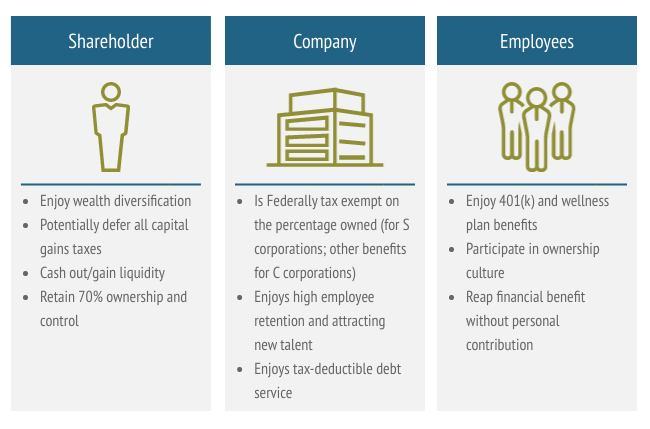Industry Trends
Largest Transactions Closed
- Target
- Buyer
- Value($mm)
Determining when and how to exit your business is one of the most important and personal career decisions you will ever make. As your privately held business matures and grows in value, you may see the potential benefits of personal liquidity and diversification become more significant. But if an all-or-nothing decision to sell your business does not appeal to you, an Employee Stock Ownership Plan (ESOP) may be a particularly attractive option, given the flexibility it provides. An ESOP can own any percentage of stock in the business, up to 100%. Your ability to control the percentage of the business you sell is one reason ESOPs are so appealing to business owners.
As one of the most flexible exit strategies, an ESOP offers many benefits to all involved parties. For example, if you sell a less-than-50% stake to the ESOP, you and your employees will benefit from:
Each of these is discussed below.
As a business owner, you must transition your stake in the company from equity to cash. Diversifying the valuable equity you’ve accumulated during the years you’ve spent building a successful business is vital for a number of reasons. Selling a portion of your equity to an ESOP achieves a balanced investment strategy; it allows you to invest in alternative sources of wealth while maintaining a majority of the equity in the business you built for future value appreciation. Obtaining that liquidity in a transaction is currently very favorable to business owners, as banks are eager to lend money in partial ESOP transactions.
You can win the tax tug-of-war with Uncle Sam with an ESOP. Congress has enacted tax incentives for ESOPs that provide advantages for not only the company but the shareholders as well. While tax benefits are greatest for companies that become 100% ESOP-owned, a partial ESOP enjoys tax benefits for the portion that is sold. Employer contributions to the ESOP are generally tax-deductible, up to a limit of 25% of covered payroll. Companies making these deductible contributions are effectively making both principal and interest debt payments tax-deductible, as opposed to non-ESOP companies, for which only interest is deductible.
If you sell at least 30% of the stock of your C corporation to an ESOP, you can defer capital gains tax on that sale. Imagine receiving $30 million from the partial sale of your company and reinvesting that in qualified securities that grow your investment 10% per annum and having those proceeds and gains go untaxed.
If you’re selling S corporation stock, all sale proceeds over the basis will be taxed as capital gains, whereas if you sell to a third party, the proceeds will likely be taxed at a blend of capital gains and ordinary income tax rates. However, the ESOP ownership portion is not federally taxed and therefore allows more cash to remain in the business for debt repayment or growth capital.
Regardless of your tax election or the percentage of your business you sell, the tax incentives for both you and the company create a compelling reason to consider an ESOP.
When you sell to an ESOP, you create a structure that lends itself to a positive company culture, one that often results in greater stock value, job security, and retirement benefits. When employees assume the employee-owner mindset, they tend to think more about how their choices and day-to-day operations affect the whole business. This fosters a positive culture that benefits them, the company, and other shareholders. In addition, the employees are likely to receive above-average returns on their stock.
ESOPs’ positive effects on company culture are not just theoretical. According to the National Center for Employee Ownership (NCEO),1 ESOP companies are 25% more likely to remain in business and over a 10-year period experience 25% higher job growth than comparable non-ESOP-owned companies. Ultimately, the enhanced productivity results in higher sales (approximately 2.3% per year). For an employee owner, this translates into a retirement account that is on average 2.5 times larger than comparable non-ESOP-owned employee retirement accounts.
Further highlighting the value of selling to an ESOP, the NCEO’s Employee Ownership (EO) Index demonstrated higher stock market returns for employee-owned companies. Over a two-year period (2017–2019), the EO Index outperformed both the S&P 500 and the Russell 3000 in each of those years. Over that period, the return of the EO Index was 48.1%, compared with 24.1% and 24.2% for the S&P 500 and Russell 3000, respectively.2
Selling a minority position in your company to an ESOP allows you to retain most of the equity in stock whose value increases as the business continues to thrive. The ESOP also affords benefits to employees and shareholders, giving you the satisfaction of seeing your company prosper in its new form. The example below highlights some of the benefits provided to all involved in a 30% sale to an ESOP.
 As a business owner, you’ve shepherded your company from launch to expansion to transition. You’ve reached milestones at each stage, and not always instantaneously. For instance, in the initial stages of a growth strategy, you may have entered a new line of business with a step-by-step approach instead of buying a company outright. Perhaps that new line of business became more viable, with less risk, as time progressed, making a gradual route the smarter way to go. Similarly, transitioning out of your business can happen over time. An ESOP will allow you to do just that and ultimately give you wealth diversification, tax-advantaged liquidity, the ability to provide meaningful employee benefits to retain and attract talent, and ownership of the majority of equity from which you can obtain a second windfall in another sale – either to the ESOP or to another company via a merger or acquisition.
As a business owner, you’ve shepherded your company from launch to expansion to transition. You’ve reached milestones at each stage, and not always instantaneously. For instance, in the initial stages of a growth strategy, you may have entered a new line of business with a step-by-step approach instead of buying a company outright. Perhaps that new line of business became more viable, with less risk, as time progressed, making a gradual route the smarter way to go. Similarly, transitioning out of your business can happen over time. An ESOP will allow you to do just that and ultimately give you wealth diversification, tax-advantaged liquidity, the ability to provide meaningful employee benefits to retain and attract talent, and ownership of the majority of equity from which you can obtain a second windfall in another sale – either to the ESOP or to another company via a merger or acquisition.
Contact us today to get more information on how an investment banker can help you get the greatest value when selling your business. Or visit our ESOP Planning Library for additional resources to guide you through the ESOP planning process.
[1] NCEO. The Economic Power of Employee Ownership
[2] Rodgers, Loren. NCEO. NCEO Employee Ownership Stock Index Continues to Double Market Returns, July 1, 2019.
Investment Banking | ESOP
ezaleski@pcecompanies.com
Chicago Office
847-851-2088 (main)
847-239-2466 (direct)
407-621-2199 (fax)
Investment Banking | ESOP
Chicago Office
847-239-2466 (direct)
ezaleski@pcecompanies.com
Connect
847-239-2466 (direct)
407-621-2199 (fax)
